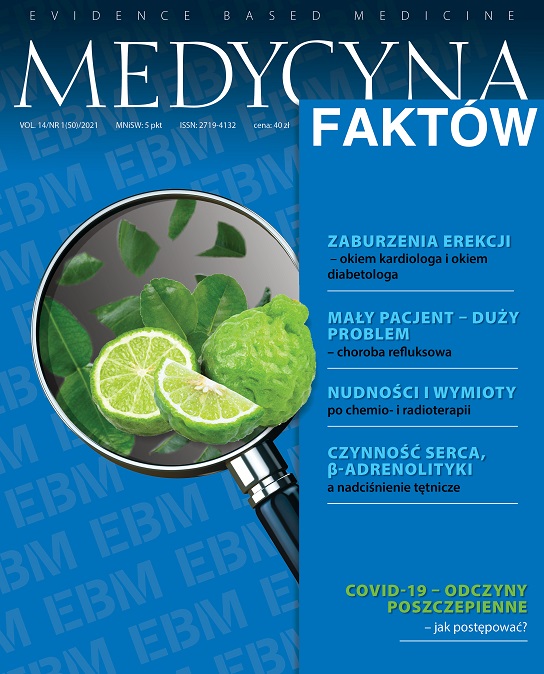Effectiveness and safety of modern treatment against nausea and vomiting induced by chemotherapy and radiotherapy Review article
Main Article Content
Abstract
Nausea and vomiting are one of most frequent side effects of chemotherapy and radiotherapy. Effective prevention and treatment of these symptoms is essential for better quality of life for patients undergoing oncological therapies. Nausea and vomiting can be acute, delayed or anticipatory. Leading mechanisms and methods of treatment are different for each of those. Most often used groups of drugs are: 5-HT3-antagonists, glucocorticosteroids, NK1-antagonists. Another important group are neuroleptics, which are therapy of choice for anticipatory vomiting. Modern antiemetic medications are in most cases safe and effective. But as every treatment it causes risks of adverse events which may be serious and difficult to manage. It applies in particular to long-acting drugs. Most common side effects are headache, constipation and sedation. But more severe or life-threatening symptoms may appear, like intestinal obstruction and serotonin syndrome. Some of the drugs also come with risk of interacting with other treatment. Changes in pharmacokinetics may lead to additional toxicities. In elderly, especially with cardiac disease, in risk of ileus or cachexia these drugs shall be used with caution.
Article Details
Copyright © by Medical Education. All rights reserved.
References
2. Shankar A, Roy S, Malik A et al. Prevention of Chemotherapy-Induced Nausea and Vomiting in Cancer Patients. Asian Pac J Cancer Prev. 2015; 16(15): 6207-13. https://doi.org/10.7314/apjcp.2015.16.15.6207.
3. Navari RM, Aapro M. Antiemetic Prophylaxis for Chemotherapy-Induced Nausea and Vomiting. N Engl J Med. 2016; 374(14): 1356-67. https://doi.org/10.1056/NEJMra1515442.
4. Antiemetic Subcommittee of the Multinational Association of Supportive Care in Cancer (MASCC). Prevention of chemotherapy- and radiotherapy- induced emesis: results of Perugia Consensus Conference. Ann Oncol. 1998; 9: 811-9. https://doi.org/10.1093/annonc/mdj078.
5. Roila F, Herrstedt J, Aapro M et al. Guideline update for MASCC and ESMO in the prevention of chemotherapy and radiotherapy-induced nausea and vomiting: results of the Perugia consensus conference. Ann Oncol Off J Eur Soc Med Oncol. 2010; 21(suppl 5): v232-43. https://doi.org/10.1093/annonc/mdq194.
6. Roila F, Molassiotis A, Herrstedt J et al. 2016 MASCC and ESMO guideline update for the prevention of chemotherapy and radiotherapy-induced nausea and vomiting and of nausea and vomiting in advanced cancer patients. Ann Oncol. 2016; 27(suppl 5): v119-33. https://doi.org/10.1093/annonc/mdw270.
7. Kawecki A, Krzakowski M. Chemotherapy- and radiotherapy-induced nausea and vomiting. Oncol Clin Pract. 2018; 14(2): 53-61. https://doi.org/10.5603/OCP.2018.0010.
8. Basch E, Prestrud AA, Hesketh PJ et al. Antiemetics: American Society of Clinical Oncology clinical practice guideline update. J Clin Oncol Off J Am Soc Clin Oncol. 2011; 29(31): 4189-98. https://doi.org/10.1200/JCO.2010.34.4614.
9. Freites-Martinez A, Santana N, Arias-Santiago S et al. Using the Common Terminology Criteria for Adverse Events (CTCAE – Version 5.0) to Evaluate the Severity of Adverse Events of Anticancer Therapies. Actas Dermosifiliogr. 2021; 112(1): 90-2. https://doi.org/10.1016/j.ad.2019.05.009.
10. Grunberg SM, Warr D, Gralla RJ et al. Evaluation of new antiemetic agents and definition of antineoplastic agent emetogenicity – state of the art. Support Care Cancer. 2011; 19(1): 43-7. https://doi.org/10.1007/s00520-010-1003-x.
11. Dupuis LL, Robinson PD, Boodhan S et al. Guideline for the prevention and treatment of anticipatory nausea and vomiting due to chemotherapy in pediatric cancer patients. Pediatr Blood Cancer. 2014; 61(8): 1506-12. https://doi.org/10.1002/pbc.25063.
12. Ripamonti C, Bruera E. Palliative management of malignant bowel obstruction. Int J Gynecol Cancer. 2002; 12(2): 135-43.
13.Navari RM. Palonosetron: a second generation 5-hydroxytryptamine 3 receptor antagonist. Expert Opin Drug Metab Toxicol. 2009; 5(12): 1577-86. https://doi.org/10.1517/17425250903407289.
14. Hesketh PJ, Rossi G, Rizzi G et al. Efficacy and safety of NEPA, an oral combination of netupitant and palonosetron, for prevention of chemotherapy- induced nausea and vomiting following highly emetogenic chemotherapy: a randomized dose-ranging pivotal study. Ann Oncol Off J Eur Soc Med Oncol. 2014; 25(7): 1340-6. https://doi.org/10.1093/annonc/mdu110.

